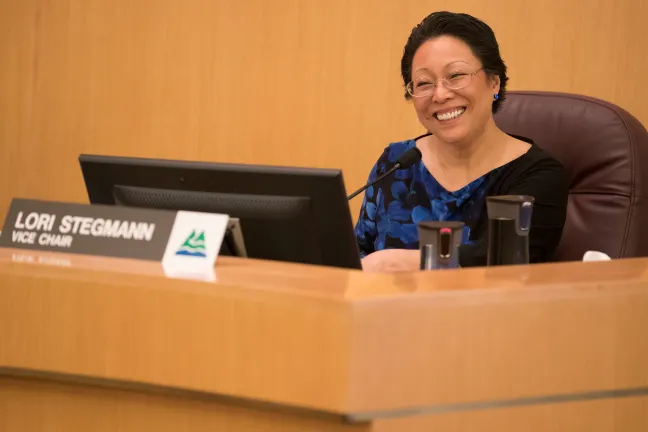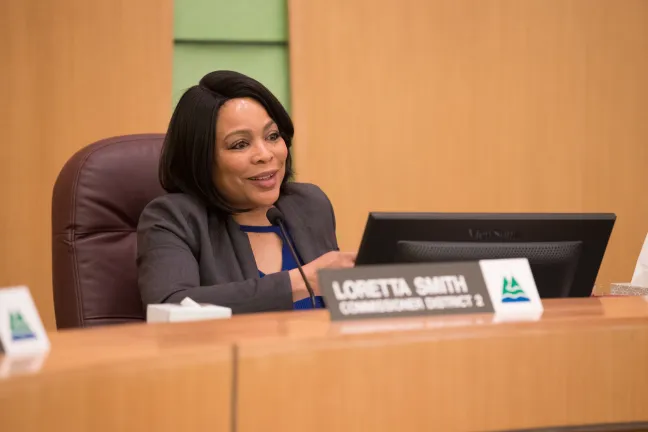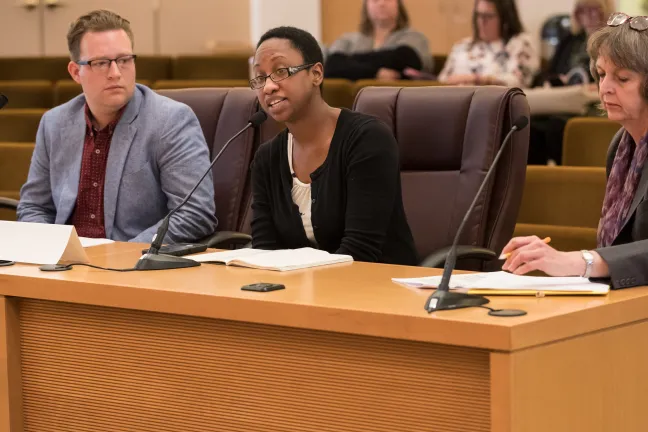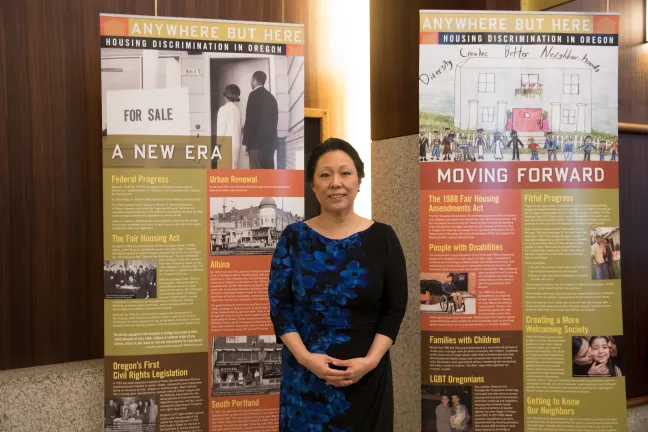The Board of Commissioners on Thursday recognized April as Fair Housing Month -- seizing on the 50th anniversary of the Fair Housing Act to recognize some progress in housing justice even as they made clear that serious and difficult work remains.
“As you may know, our history of housing in Oregon and Multnomah County has a somber past. Many of you have heard stories or perhaps lived through the practices of redlining, eminent domain and segregation,” said Commissioner Lori Stegmann, who sponsored the proclamation.
“Even with fair housing laws, there are still communities that struggle and face discrimination,” she continued. “We need to arm ourselves with the knowledge of our history so those mistakes are not made in the future.”
Congress passed the Fair Housing Act in April 1968, lifting it from political limbo in part to end the days of community outrage that erupted after a white man assassinated the Rev. Dr. Martin Luther King Jr.
The law initially banned discrimination based on race, color, religion and national origin. Later, in 1974 and 1988, it was amended to offer protections for gender, family status and neighbors with disabilities.
But Stegmann and other commissioners, as well as invited speakers from the Fair Housing Council of Oregon and the Community Alliance of Tenants, said discrimination remains a force driving the displacement of people of color and people with lower incomes to the county’s margins as housing prices continue to surge past median incomes.
“This is a huge opportunity to give a look back at where we were before,” Commissioner Loretta Smith said. “We do know we have a long way to go.”
Stegmann called the anniversary “especially meaningful in our current housing crisis, in which our most vulnerable residents are disproportionately impacted.” She also said an exhibit on Oregon’s history of discrimination, on loan from the housing council, will be in the Multnomah Building lobby through April 25.
“While we celebrate,” she said, “I hope this proclamation and the voices we hear today will motivate and stir something inside of us to renew our commitment to recognize and ameliorate the discrimination and systemic oppression facing our communities.”
Lingering legacy of discrimination
Katrina Holland, director of the Community Alliance of Tenants, said it was difficult for her to testify about the law, given Oregon’s lingering legacy of segregation and racist housing laws and banking practices. Holland’s group is on the front lines of the city’s housing crisis, helping hundreds of people every year navigate evictions, landlord disputes and rent hikes.
For decades after its founding, Oregon banned African Americans from living in the state. Later, people of color were explicitly denied home loans and forced to live in prescribed sections of the community that were either starved of services or bulldozed into oblivion, like parts of Albina around the old Emanuel Hospital and Memorial Coliseum.
Many of those bluntly racist practices have ended or softened. But people of color continue to see disproportionately harsh housing outcomes, Holland said.
“We’ve made great steps forward, but we have a really long way to go,” she said.
In communities studied by the Supporting Partnerships Against Racist Communities group, which is working with leaders in Multnomah County to address disparities in homelessness, African Americans made up 34.1 percent of people experiencing deep poverty — but 64.7 percent of people experiencing homelessness. No part of the city of Portland is affordable for an average African American family.
And renewal in traditionally African American neighborhoods has brought high rents and home prices, rapidly transforming them into places where affluent white residents make up the largest share of residents.
Black neighbors who wanted those improvements for years instead have increasingly moved to less expensive parts of the community -- far from cultural touchstones and far from the city center, with its jobs, amenities and richer transit network.
“We’re just as divided since we passed the Fair Housing Act, and in some instances a little bit worse,” Holland said. “Displacement makes it harder to join in community activities, keep a sense of community, take kids to schools and get to jobs in other parts of the city.”
“It wasn’t only the private market”
Discrimination echoes loudly today, said Diane Hess, outreach director at the Fair Housing Council of Oregon, which educates landlords on compliance with housing laws and helps residents pursue any claims over violations.
Within historic African American neighborhoods, Hess said, lenders, assessors and appraisers cited the presence of people of color to lower property values and deny loans.
That fear worked against efforts to integrate neighborhoods or equitably locate public housing. In addition, while many white Americans reaped the benefits of home ownership after World War II, amassing generational wealth that helped stabilize their families, that opportunity was largely denied to African Americans.
The Federal Housing Authority pioneered 30-year loans and smaller down payments in the mid-20th century, literally opening the doors of home ownership for millions of Americans. But only 2 percent of the $120 billion in mortgage loans awarded from the 1930s to 1960s went to African Americans.
“It wasn’t only the private market but governments that continued to maintain and worsen the situation,” Hess said. “When you look at the wealth gap between whites and people of color, home equity is a large part.”
Chair Deborah Kafoury said that lesson should be front of mind for those who think the community could solve its homelessness crisis if only more neighbors would “pull themselves up by their bootstraps.”
“When you think of white Oregonians in particular who have had generations of home ownership and have had that opportunity for wealth accumulation that has been denied to people of color,” Kafoury said, “it’s not just about people pulling themselves up by their bootstraps. It’s about overcoming huge barriers that have been put in place over years and years.”
“Still bearing bitter fruit today”
Board members reflected on the continuing struggles of communities of color and other groups -- particularly with the Trump Administration raising concerns that it might step fair housing enforcement down, instead of up, and potentially work to dismantle parts of the law.
“This is something that’s active, it’s going on, it’s a living thing and we have to fight for it, both at the local level and nationally,” Commissioner Jessica Vega Pederson said. “We haven’t made enough gains on this to lose any ground. There’s a real legacy of the racism that’s been in our housing policies, and it’s still bearing bitter fruit today.”
“A lot of times we say things like, ‘We’ve come really far, but not far enough,’” Commissioner Sharon Meieran said. “But in Portland, we haven’t even come really far when you look at the realities of the situation here.”
Holland laid out some ideas for how to advance the work -- from rent stabilization to new fees to relocation payments to new standards that ensure units facing rent increases are actually habitable and up to code.
“Before we become San Francisco or New York, highly segregated, we can take bold action to move from reactivity to proactivity,” she said.
But she also said leaders at the County and across the region have made some recent strides, thanks to investments in housing and homelessness services, a new housing bond, and increased regional coordination on policies such as supportive housing.
“We have seen it make a difference,” she said. “We are moving in a positive direction.”




